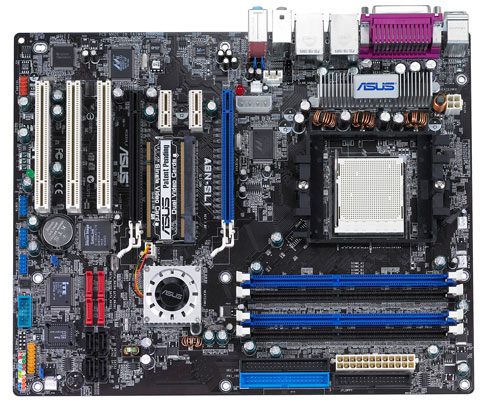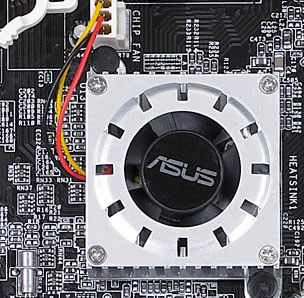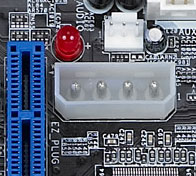NVIDIA's GeForce 6 SLI: Demolishing Performance Barriers
by Anand Lal Shimpi on November 23, 2004 10:23 AM EST- Posted in
- GPUs
ASUS’ A8N-SLI Deluxe
ASUS and NVIDIA have been working very closely with each other on the nForce4 SLI project. NVIDIA took ASUS’ A8N-SLI Deluxe on tour with them, doing demonstrations to reviewers all over the world based on this one motherboard. Obviously the partnership has irritated a few of ASUS’ competitors, and thus it looks like Gigabyte and MSI are doing their best to get their competing boards out as soon as possible. But ASUS was the first to get us a final board and thus we have them in our review today.

The very first A8N-SLI Deluxe motherboard we received was horribly unstable and we spent the majority of our time just trying to get the thing to work. Our sample was one of 10 in the world and fortunately not a mass production sample. ASUS managed to get us another board in time for the publication of this review, and the updated board fixed all of our issues. We will be sure to do a full review on ASUS’ SLI motherboard featured here, but for now here’s some brief information about the board.
The A8N-SLI Deluxe is a very interesting solution from ASUS as it will be targeted at both the high end and mainstream Socket-939 markets. With a price point of around $180, ASUS is hoping that all types of users, from casual to hardcore gamers will flock to the A8N-SLI Deluxe to either take advantage of SLI immediately or have the security of a SLI upgrade path.
The board itself is as feature filled as you could possibly imagine. Featuring 3 x 32-bit PCI, 2 PCI Express x1 and 2 PCI Express x8 slots, the board is pretty balanced when it comes to add-in card expansion.
ASUS spread the two PCI Express x8 slots out a bit more than some manufacturers have planned to do, in order to improve cooling when running two cards in SLI mode. ASUS also supplies a bridge PCB appropriately sized to accommodate the distance between the two PCI Express connectors. The card that reconfigures the PCI Express lane arrangement from the chipset is wedged in between the two PCI Express x8 slots. The card can be a little difficult to get to at times, but with a bit of patience it’s not too big of a deal.
The actual nForce4 SLI chipset is placed between the two PCI Express x8 slots, but shifted down to be as far away from the heat producing GPUs as possible. The problem is that with 2-slot cards such as the GeForce 6800 Ultra there is not much clearance over the top of the chipset’s heatsink, which limited the size of the heatsink that ASUS could put on the motherboard. The end result is that while the heatsink and fan do the best job they can, the heatsink gets extremely hot. Just something to keep an eye out for.

The nForce4 SLI chipset on the A8N-SLI Deluxe
By using a separate Silicon Image SATA controller in conjunction with the nForce4 SLI’s built in SATA controller, the A8N-SLI supports a maximum of 8 SATA drives. Impressively enough, ASUS provides 4-pin molex to SATA power adapters and SATA cables for all of the ports. ASUS went one step further and also bundles a card that allows you to plug a SATA drive (and power) into your motherboard, externally without ever opening your case. By running two SATA ports and one power connector to a slot cutout you can plug any SATA drive and use it externally. Remember that since the nForce4 SLI chipset supports the SATA II specification, you can use this external port with hot pluggable SATA II drives.
In order to aid in power delivery to a power hungry SLI setup, ASUS implemented what they are calling their “EZ-PLUG” connector on the board. The EZ-PLUG is basically a 4-pin molex connector on the board itself that is designed to provide an additional 12V line to the graphics cards in SLI mode. Using the plug isn’t necessary (we tested both with and without it and in both cases it worked fine), but ASUS insists you use it in SLI mode to guarantee stability. If you don’t apply power to the EZ-PLUG and you are in SLI mode, a red LED lights up on the motherboard and a warning will appear at POST telling you that you forgot to supply power to the EZ-PLUG.

ASUS' EZ-PLUG
ASUS is expecting mass production of the A8N-SLI Deluxe to commence in the coming weeks; this is an extremely important motherboard for ASUS and they have extended their promise to us that it will be widely available before the holidays, most likely starting the first week of December.
We are pretty happy with what we’ve seen from ASUS with their A8N-SLI Deluxe, but we’ll save the full evaluation of the motherboard for our review of the board itself. With a working sample of the board in hand it looks like ASUS has worked out any issues we had with the first sample of the board, and it should make for a nice gift (for someone special or yourself of course) for the holiday gamer.










74 Comments
View All Comments
bob661 - Tuesday, November 23, 2004 - link
I find it absolutely amazing that they were CPU limited using a 4000+.Avalon - Tuesday, November 23, 2004 - link
Anand, you keep saying that a 6600GT in SLI outperforms a 6800U in Doom 3 and HL2, but your benchmarks look partially wrong to be concluding that. It seems it would be more correct if you said that a 6600GT in SLI outperforms a single 6800U in lower res, lower bandwidth situations (such as 12x10 with low AA/AF, or less), but in high res and bandwidth situations (such as 16x12 with a bit of AA/AF), the 6600GT doesn't appear to be able to keep up at all with a single 6800U. Buyers will need to take that into consideration, to make sure that the video setup they will be purchasing will meet their needs specifically.lifeguard1999 - Tuesday, November 23, 2004 - link
One simple question: Are there Linux drivers that support SLI?Historically, people have talked about a setup either being CPU bound or GPU bound. That is no longer the case. With SLI it appears that the limiting factor is data. Simply put, there is not enough data for the dual GPU's to render. This is a common problem in parallel programming, especially when you are talking about thousands of processors. By increasing the amount of data for the GPU to render, one can see that SLI performs better.
For example, at 1600x1200, the increase is only 20% going from simgle 6800U to 6800U-SLI. Now by increasing the amount of work for the GPU to perform (1600x1200 with 4X AA and 8X AF), the performance increases 48% going from simgle 6800U to 6800U-SLI.
What this means is that game developers can now have Low, Medium, High, Ultra, and Ultra-SLI rendering modes in their games. :) What a nice "problem" to have.
In my line of work (Scientific Visualization) where we can have models up to hundreds of millions of polygons, SLI is going to cause a revolution in how we do business.
Alphafox78 - Tuesday, November 23, 2004 - link
wow, if I my LCD went to 1600x1200 SLI might help me slightly... I wonder what % of people actually play with the res that high. at 1280x1024 with my 6800GT AGP overclocked to ultra speeds with 4x aa and 8x anistropic I noticed no slowdowns in the game, smooth as can be for 95% of the game.GhandiInstinct - Tuesday, November 23, 2004 - link
Yes, great performance increase, but its too expensive to afford for most people. Unless you're 3 generations behind and need a new system chances are you'll buy this but not for people that have stabe up to par systems. This just isn't a wise investment when ATI's multi-gpu technology is right around the corner which doesn't limit you to the inferior Nvidia.OriginalReaper - Tuesday, November 23, 2004 - link
I dont see why 8xAA wasn't used. It's clearly not GPU limited at 4xAA 8xAF.blckgrffn - Tuesday, November 23, 2004 - link
I am glad that NVIDIAs drivers seem fairly mature already, hopefully they will have a new release out by the time SLI becomes "mainstream". It would have been awful had this real release been tainted by a lot of driver issues. So, the real point here is that if you really want performance, you have to drop $800 at some point? Wow. Two 6600GTs already are not the optimum choice for 1600*1200, so a 6800GT is what should be purchased now if you are really all about fps. Hmmm. I suppose I do know people who would like the incremental upgrade path, but I am not one of them when it comes to graphics cards - I sell my "old" one just before the new product cycle really starts appearing in quanities on the shelves and go for the new technology, and I am guessing that many who have $800 to spend on graphics cards would do something similar. I am jealous of those who will be able to spring for a big-power SLI setup out of pocket...dak - Tuesday, November 23, 2004 - link
I'm curious, is it possible to use two PCI-X video cards in these SLI boards, but not have them configured SLI? I have some applications that would benefit greatly from having two high end dual output cards in a single computer.....shabby - Tuesday, November 23, 2004 - link
Great article Anand, can you mention which psu you used to feed those hungry 6800 ultra's?Aquila76 - Tuesday, November 23, 2004 - link
Looks like SLI'd 6800GT's are a great option for now. I'm greatly awaiting ATI's Multi-Rendering products now. Can't wait for that benchmark setup!